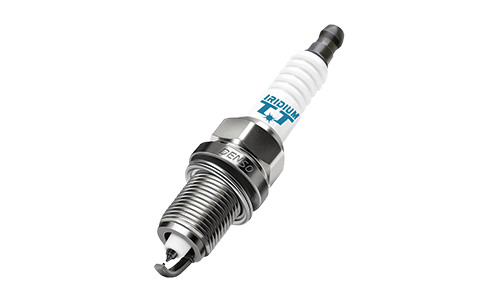Background
When a spark plug fires, the plasma discharge ignites the A/F mixture between and near the electrodes. This creates a spherical flame front that propagates outward into the combustion chamber. At first, the flame front moves very slowly because of its small original size, and because it does not generate enough energy to quickly heat the surrounding gases. Consequently, the cylinder pressure does not rise very quickly and very little compression heating takes place. Since it's not the actual electricity, or spark, that ignites the A/F mixture but rather the heat energy generated by the discharge, it's desirable to have as little of that heat as possible re-absorbed by the center and ground electrodes and the ceramic insulator. Additionally, the larger the center and ground electrodes, the more confined the spherical flame front and the more difficult for it to move outward into the combustion chamber to intiate the flame propagation phase. This phenomenon is referred to as "quench."
To reduce quench, spark plug manufacturers have resorted to various techniques. Denso has used a U-Groove ground electrode, NGK a V-Groove center electrode design, and tapered and cut-back ground electrodes are also employed. The use of platinum and iridium with their greater hardness and higher melting point temperatures than nickel alloy has made possible fine wire center and ground electrodes. By reducing the contact (surface) area between the electrodes and the flame front, quenching is reduced. The latest method employs fine wire ground electrodes. The intent is to increase the space between the electrodes without increasing the plug gap.
Denso
This maker calls its new design TT, which stands for Twin-Tip. It consists of a 1.1 mm platinum alloy center electrode and a 1.5 mm titanium-enhanced alloy free-standing firing pad (tip) laser welded to the ground strap.

Diagram from Denso comparing conventional ground electrode with TT type. Illustrates increased space between electrodes, reducing quench, while maintaining same plug gap.

Denso TT plug as used in 2.0 L FS-DE engine.
Denso calls this a minimum quench electrode design and claims improved fuel economy, faster starts and enhanced flame propagation for increased engine efficiency.
Apparently, production has advanced to the point of fairly complete availability including types designated for all Proteges.
NGK
NGK's offering is known as DFE, which stands for Double Fine Electrode. It's constructed with an iridium center electrode and an iridium ground electrode (tip) laser welded to the ground strap.

NGK DFE Plug. Note tapered ground strap as well as fine wire ground electrode.
The manufacturer claims ultra high ignitability and increased service life compared with their current offerings. NGK points out that DFE spark plugs are manufactured in accordance with OEM requirements and, as such, only a limited range is available to suit specific applications. So for the present, they are not yet available for our cars.
Happy Motoring!
When a spark plug fires, the plasma discharge ignites the A/F mixture between and near the electrodes. This creates a spherical flame front that propagates outward into the combustion chamber. At first, the flame front moves very slowly because of its small original size, and because it does not generate enough energy to quickly heat the surrounding gases. Consequently, the cylinder pressure does not rise very quickly and very little compression heating takes place. Since it's not the actual electricity, or spark, that ignites the A/F mixture but rather the heat energy generated by the discharge, it's desirable to have as little of that heat as possible re-absorbed by the center and ground electrodes and the ceramic insulator. Additionally, the larger the center and ground electrodes, the more confined the spherical flame front and the more difficult for it to move outward into the combustion chamber to intiate the flame propagation phase. This phenomenon is referred to as "quench."
To reduce quench, spark plug manufacturers have resorted to various techniques. Denso has used a U-Groove ground electrode, NGK a V-Groove center electrode design, and tapered and cut-back ground electrodes are also employed. The use of platinum and iridium with their greater hardness and higher melting point temperatures than nickel alloy has made possible fine wire center and ground electrodes. By reducing the contact (surface) area between the electrodes and the flame front, quenching is reduced. The latest method employs fine wire ground electrodes. The intent is to increase the space between the electrodes without increasing the plug gap.
Denso
This maker calls its new design TT, which stands for Twin-Tip. It consists of a 1.1 mm platinum alloy center electrode and a 1.5 mm titanium-enhanced alloy free-standing firing pad (tip) laser welded to the ground strap.
Diagram from Denso comparing conventional ground electrode with TT type. Illustrates increased space between electrodes, reducing quench, while maintaining same plug gap.
Denso TT plug as used in 2.0 L FS-DE engine.
Denso calls this a minimum quench electrode design and claims improved fuel economy, faster starts and enhanced flame propagation for increased engine efficiency.
Apparently, production has advanced to the point of fairly complete availability including types designated for all Proteges.
NGK
NGK's offering is known as DFE, which stands for Double Fine Electrode. It's constructed with an iridium center electrode and an iridium ground electrode (tip) laser welded to the ground strap.
NGK DFE Plug. Note tapered ground strap as well as fine wire ground electrode.
The manufacturer claims ultra high ignitability and increased service life compared with their current offerings. NGK points out that DFE spark plugs are manufactured in accordance with OEM requirements and, as such, only a limited range is available to suit specific applications. So for the present, they are not yet available for our cars.
Happy Motoring!



Comment